Verification of Non-thermal Effects of 0.3–0.6 THz-Waves on Human Cultured Cells
Abstract
:1. Introduction
2. Materials and Methods
2.1. THz Wave Source
2.2. Cells Used for the THz Wave Exposure
2.3. Cell Proliferation
2.4. Cell Viability
2.5. Morphological Observations of Human Corneal Cells (HCE-T) Exposed
2.6. Assessment of the Level of Heat Shock Protein 70 mRNA Expression
2.7. Statistical Analysis Method
3. Results
3.1. Cell Proliferation
3.2. Cell Viability
3.3. Morphological Observations of Human Corneal Cells (HCE-T) Exposed
3.4. Detection of HSP70 mRNA Expression
4. Discussion
5. Conclusions
Author Contributions
Funding
Acknowledgments
Conflicts of Interest
References
- Tonouchi, M. Cutting edge terahertz technology. Nat. Photonics 2007, 1, 97–105. [Google Scholar] [CrossRef]
- Song, H.-J.; Ajito, K.; Muramoto, Y.; Wakatsuki, A.; Nagatsuma, T.; Kukutsu, N. 24 Gbit/s data transmission in 300 GHz band for future terahertz communications. Electron. Lett. 2012, 48, 953–954. [Google Scholar] [CrossRef]
- Nagatsuma, T. Breakthroughs in photonics 2013; THz communications based on photonics. IEEE Photonics J. 2014, 6, 0701505. [Google Scholar] [CrossRef]
- Mattsson, M.-O.; Zeni, O.; Simko, M. Is there a biological basis for therapeutic applications of millimeter waves and THz waves? J. Infrared Millim. Terahertz Waves 2018, 39, 863–878. [Google Scholar] [CrossRef]
- Wilmink, G.J.; Grundt, J.E. Invited Review Article: Current state of research on biological effects of terahertz radiation. J. Infrared Millim. Terahertz Waves 2011, 32, 1074–1122. [Google Scholar] [CrossRef]
- Scientific Committee on Emerging and Newly Identified Health Risks (SCENIHR). Final Opinion on Potential Health Effects of Exposure to Electromagnetic Fields (EMF) 2015. Available online: https://ec.europa.eu/health/scientific_committees/emerging/docs/scenihr_o_041.pdf (accessed on 22 March 2019).
- Korenstein-Ilan, A.; Barbul, A.; Hasin, P.; Eliran, A.; Gover, A.; Korenstein, R. Terahertz radiation increases genomic instability in human lymphocytes. Radiat. Res. 2008, 170, 224–234. [Google Scholar] [CrossRef]
- Homenko, A.; Kapilevich, B.; Kornstein, R.; Firer, M.A. Effects of 100 GHz radiation on alkaline phosphatase activity and antigen-antibody interaction. Bioelectromagnetics 2009, 30, 167–175. [Google Scholar] [CrossRef] [PubMed]
- Hintzsche, H.; Jastrow, C.; Kleine-Ostmann, T.; Stopper, H.; Schmid, E.; Schrader, T. Terahertz radiation induces spindle disturbances in human-hamster hybrid cells. Radiat. Res. 2011, 175, 569–574. [Google Scholar] [CrossRef] [PubMed]
- Hintzsche, H.; Jastrow, C.; Kleine-Ostmann, T.; Kärst, U.; Schrader, T.; Stopper, H. Terahertz electromagnetic fields (0.106 THz) do not induce manifest genomic damage in vitro. PLoS ONE 2012, 7, e46397. [Google Scholar] [CrossRef]
- De Amicis, A.; Sanctis, S.D.; Cristofaro, S.D.; Franchini, V.; Lista, F.; Regalbuto, E.; Giovenale, E.; Gallerano, G.P.; Nenzi, P.; Bei, R.; et al. Biological effects of in vitro THz radiation exposure in human foetal fibroblasts. Mutat. Res. Genet. Toxicol. Environ. Mutagen. 2015, 793, 150–160. [Google Scholar] [CrossRef]
- Koyama, S.; Narita, E.; Shimizu, Y.; Shiina, T.; Taki, M.; Shinohara, N.; Miyakoshi, J. Twenty Four-Hour Exposure to a 0.12 THz Electromagnetic Field Does Not Affect the Genotoxicity, Morphological Changes, or Expression of Heat Shock Protein in HCE-T Cells. Int. J. Environ. Res. Public Health 2016, 13, 793. [Google Scholar] [CrossRef]
- Yaekashiwa, N.; Otsuki, S.; Hayashi, S.; Kawase, K. Investigation on the non-thermal effects of exposing cells to 70–300 GHz using a widely tunable source. J. Radiat. Res. 2018, 59, 116–121. [Google Scholar] [CrossRef]
- Alexandrov, B.S.; Rasmussen, K.Ø.; Bishop, A.R.; Usheva, A.; Alexandrov, L.B.; Chong, S.; Dagon, Y.; Booshehri, L.G.; Mielke, C.H.; Phipps, M.L.; et al. Non-thermal effects of terahertz radiation on gene expression in mouse stem cells. Biomed. Opt. Express 2011, 2, 2679–2689. [Google Scholar] [CrossRef] [PubMed] [Green Version]
- Hintzsche, H.; Jastrow, C.; Heinen, B.; Baaske, K.; Kleine-Ostmann, T.; Schwerdtfeger, M.; Shakfa, M.K.; Kärst, U.; Koch, M.; Schrader, T.; et al. Terahertz radiation at 0.380 THz and 2.520 THz does not lead to DNA damage in skin cells in vitro. Radiat. Res. 2013, 179, 38–45. [Google Scholar] [CrossRef]
- Hwang, Y.; Ahn, J.; Mun, J.; Bae, S.; Jeong, Y.U.; Vinokurov, N.A.; Kim, P. In vivo analysis of THz wave irradiation induced acute inflammatory response in skin by laser-scanning confocal microscopy. Opt. Express 2014, 22, 11465–11475. [Google Scholar] [CrossRef]
- Bogomazova, A.N.; Vassina, E.M.; Goryachkovskaya, T.N.; Popik, V.M.; Sokolov, A.S.; Kolchanov, N.A.; Lagarkova, M.A.; Kiselev, S.L.; Peltek, S.E. No DNA damage response and negligible genome-wide transcriptional changes in human embryonic stem cells exposed to terahertz radiation. Sci. Rep. 2015, 5, 7749. [Google Scholar] [CrossRef] [Green Version]
- Sergeeva, S.; Demidova, E.; Sinitsyna, O.; Goryachkovskaya, T.; Bryanskaya, A.; Semenov, A.; Meshcheryakova, I.; Dianov, G.; Popik, V.; Peltek, S. 2.3THz radiation: Absence of genotoxicity/mutagenicity in Escherichia coli and Salmonella typhimurium. Mutat. Res. Genet. Toxicol. Environ. Mutagen. 2016, 803–804, 34–38. [Google Scholar] [CrossRef] [PubMed]
- Demidova, E.V.; Goryachkovskaya, T.N.; Mescheryakova, I.A.; Malup, T.K.; Semenov, A.I.; Vinokurov, N.A.; Kolchanov, N.A.; Popik, V.M.; Peltek, S.E. Impact of terahertz radiation on stress-sensitive genes of E. coli cell. IEEE Trans. Terahertz Sci. Technol. 2016, 6, 435–441. [Google Scholar] [CrossRef]
- Fröhlich, H. Long-range coherence and energy storage in biological systems. Int. J. Quant. Chem. 1968, 2, 641–649. [Google Scholar] [CrossRef]
- Grundler, W.; Keilmann, F.; Fröhlich, H. Resonant growth rate response of yeast cells irradiated by weak microwaves. Phys. Lett. A 1977, 62, 463–466. [Google Scholar] [CrossRef]
- Grundler, W.; Keilmann, F. Sharp resonances in yeast growth prove nonthermal sensitivity to microwaves. Phys. Rev. Lett. 1983, 51, 1214–1216. [Google Scholar] [CrossRef]
- Jelinek, F.; Saroch, J.; Kucera, O.; Hasek, J.; Pokorny, J.; Jaffrezic-Renault, N.; Ponsonnet, L. Measurement of electromagnetic activity of yeast cells at 42 GHz. Radioengineering 2007, 16, 36–39. Available online: http://hdl.handle.net/11012/57274 (accessed on 22 March 2019).
- Clothier, R.H.; Bourne, N. Effects of THz exposure on human primary kerationocyte differentiation and viability. J. Biol. Phys. 2003, 29, 179–185. [Google Scholar] [CrossRef] [PubMed]
- Wilmink, G.J.; Rivest, B.D.; Lbey, B.L.; Roth, C.L.; Bernhard, J.; Roach, W.P. Quantitative investigation of the bioeffects associated with terahertz radiation. Proc. SPIE 2010, 7562, 75620L. [Google Scholar]
- Demidova, E.V.; Goryachkovskaya, T.N.; Malup, T.K.; Bannikova, S.V.; Semenov, A.I.; Vinokurov, N.A.; Kolchanov, N.A.; Popik, V.M.; Peltek, S.E. Studying the non-thermal effects of terahertz radiation on E. coli/pKatG-gfp biosensor cells. Bioelectromagnetics 2013, 34, 15–21. [Google Scholar] [CrossRef] [PubMed]
- Ito, H.; Nagatsuma, T.; Ishibashi, T. Uni-traveling-carrier photodiodes for high-speed detection and broadband sensing. Proc. SPIE 2007, 6479, 64790X. [Google Scholar] [CrossRef]
- Ishibashi, T.; Muramoto, Y.; Yoshimatsu, T.; Ito, H. Continuous THz wave generation by photodiodes up to 2.5 THz. In Proceedings of the 38th International Conference Mainz (IRMMW-THz), Mainz, Germany, 1–6 September 2013; pp. 1–2. [Google Scholar] [CrossRef]
- Araki-Sasaki, K.; Ohashi, Y.; Sasabe, T.; Hayashi, K.; Watanabe, H.; Tano, Y.; Handa, H. An SV40-immortalized human corneal epithelial cell line and its characterization. Investig. Ophthalmol. Vis. Sci. 1995, 36, 614–621. [Google Scholar]
- Mosmann, T. Rapid colorimetric assay for cellular growth and survival: Application to proliferation and cytotoxicity assays. J. Immunol. Methods 1983, 65, 55–63. [Google Scholar] [CrossRef]
- Barltrop, J.A.; Owen, T.C.; Cory, A.H.; Cory, J.G. 5-(3-carboxymethoxyphenyl)-2-(4,5-dimethylthiazolyl)-3-(4-sulfophenyl)tetrazolium, inner salt (MTS) and related analogs of 3-(4,5-dimethylthiazolyl)-2,5-diphenyltetrazolium bromide (MTT) reducing to purple water-soluble formazans as cell-viability indicators. Bioorg. Med. Chem. Lett. 1991, 1, 611–614. [Google Scholar] [CrossRef]
- Wang, S.M.; Khandekar, J.D.; Kaul, K.L.; Winchester, D.J.; Morimoto, R.I. A method for the quantitative analysis of human heat shock gene expression using a multiplex RT-PCR assay. Cell Stress Chaperones 1999, 4, 153–161. [Google Scholar] [CrossRef] [PubMed]
- Sun, L.; Ke, Y.; Wang, K.; Lu, D.; Hu, H.; Gao, X.; Wang, B.; Zheng, W.; Lou, J.; Wu, W. Effects of 1.8 GHz radiofrequency field on DNA damage and expression of heat shock protein 70 in human lens epithelial cells. Mutat. Res. 2006, 602, 135–142. [Google Scholar] [CrossRef]
- Hadjiloucas, S.; Chahal, M.S.; Bowen, J.W. Preliminary results on the non-thermal effects of 200–350 GHz radiation on the growth rate of S. cerevisiae cells in microcolonies. Phys. Med. Biol. 2002, 47, 3831–3839. [Google Scholar] [CrossRef]
- Titova, L.V.; Ayesheshim, A.K.; Golubov, A.; Fogen, D.; Rodriguez-Juarez, R.; Hegmann, F.A.; Kovalchuk, O. Intense THz pulses cause H2AX phosphorylation and activate DNA damage response in human skin tissue. Biomed. Opt. Express 2013, 4, 559–568. [Google Scholar] [CrossRef] [PubMed] [Green Version]
- Rall, W.F.; Fahy, G.M. Ice-free cryopreservation of mouse embryos at −196 degrees C by vitrification. Nature 1985, 313, 573–575. [Google Scholar] [CrossRef] [PubMed]
- Hempling, H.G. Mass transfer of liquids across biological barriers. In NATO ASI Series A: The Biophysics of Organ Cryopreservation; Springer: Berlin/Heidelberg, Germany, 1987; Volume 147, pp. 51–78. [Google Scholar]
- Suzuki, T.; Komada, H.; Takai, R.; Arii, K.; Kosima, T.T. Relation between toxicity of cryoprotectant DMSO and its concentration in several fish embryo. Fish. Sci. 1995, 61, 193–197. [Google Scholar] [CrossRef]
- Williams, R.; Schofield, A.; Holder, G.; Downes, J.; Edgar, D.; Harrison, P.; Siggel-King, M.; Surman, M.; Dunning, D.; Hill, S.; et al. The influence of high intensity terahertz radiation on mammalian cell adhesion, proliferation and differentiation. Phys. Med. Biol. 2013, 58, 373–391. [Google Scholar] [CrossRef] [PubMed]
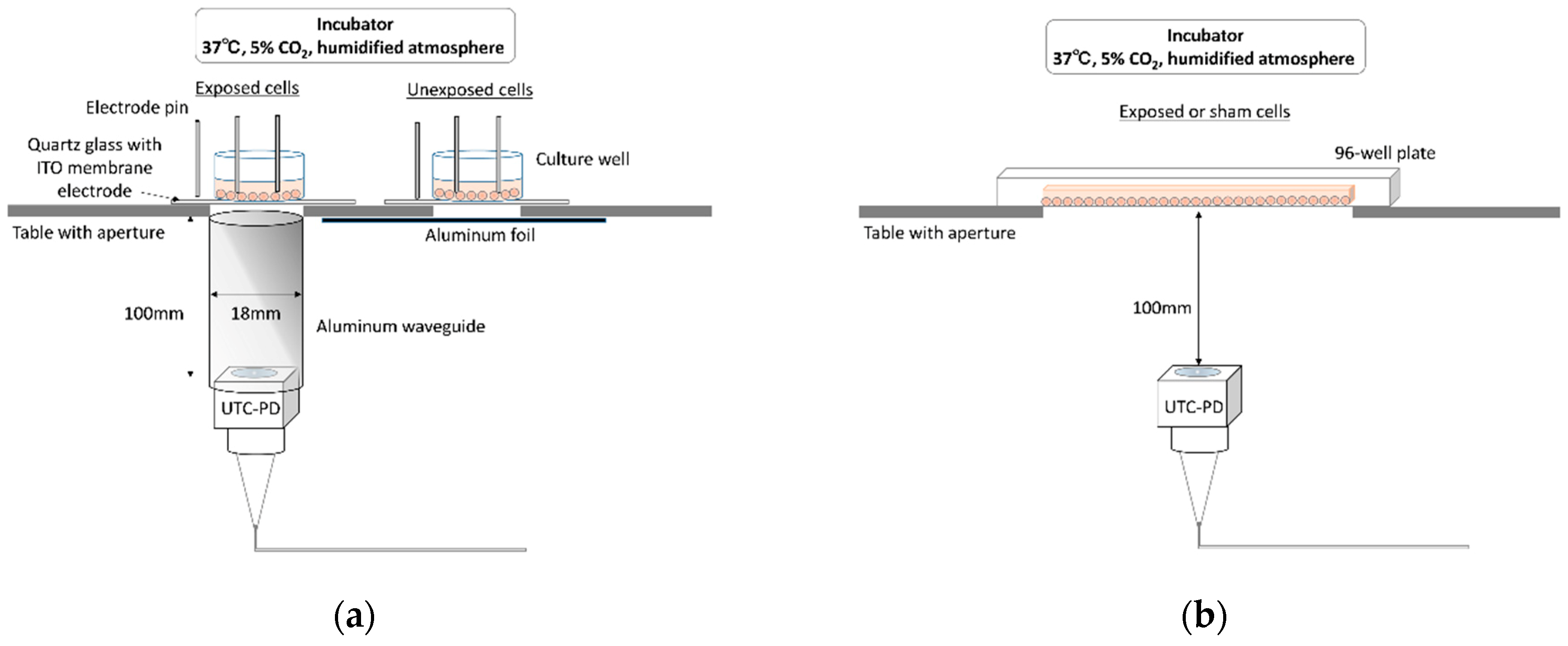
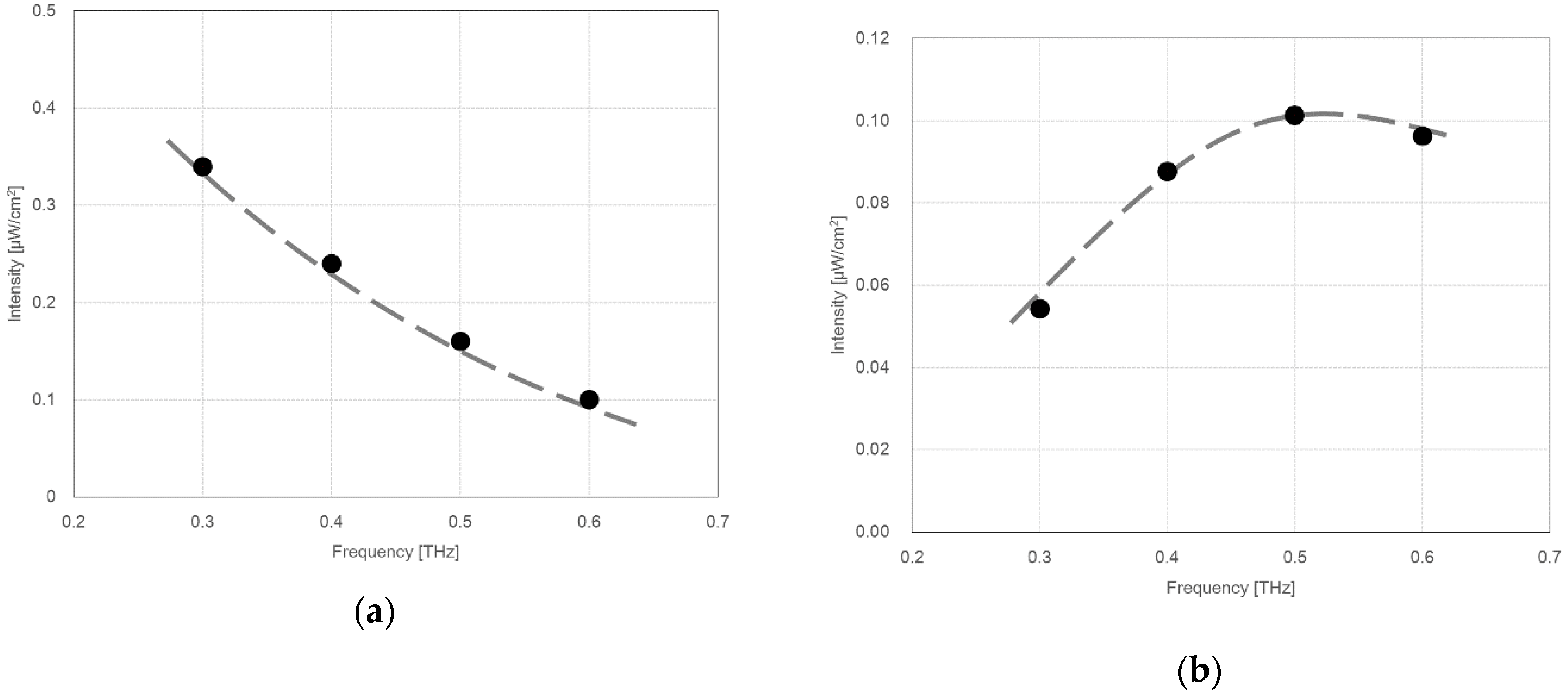
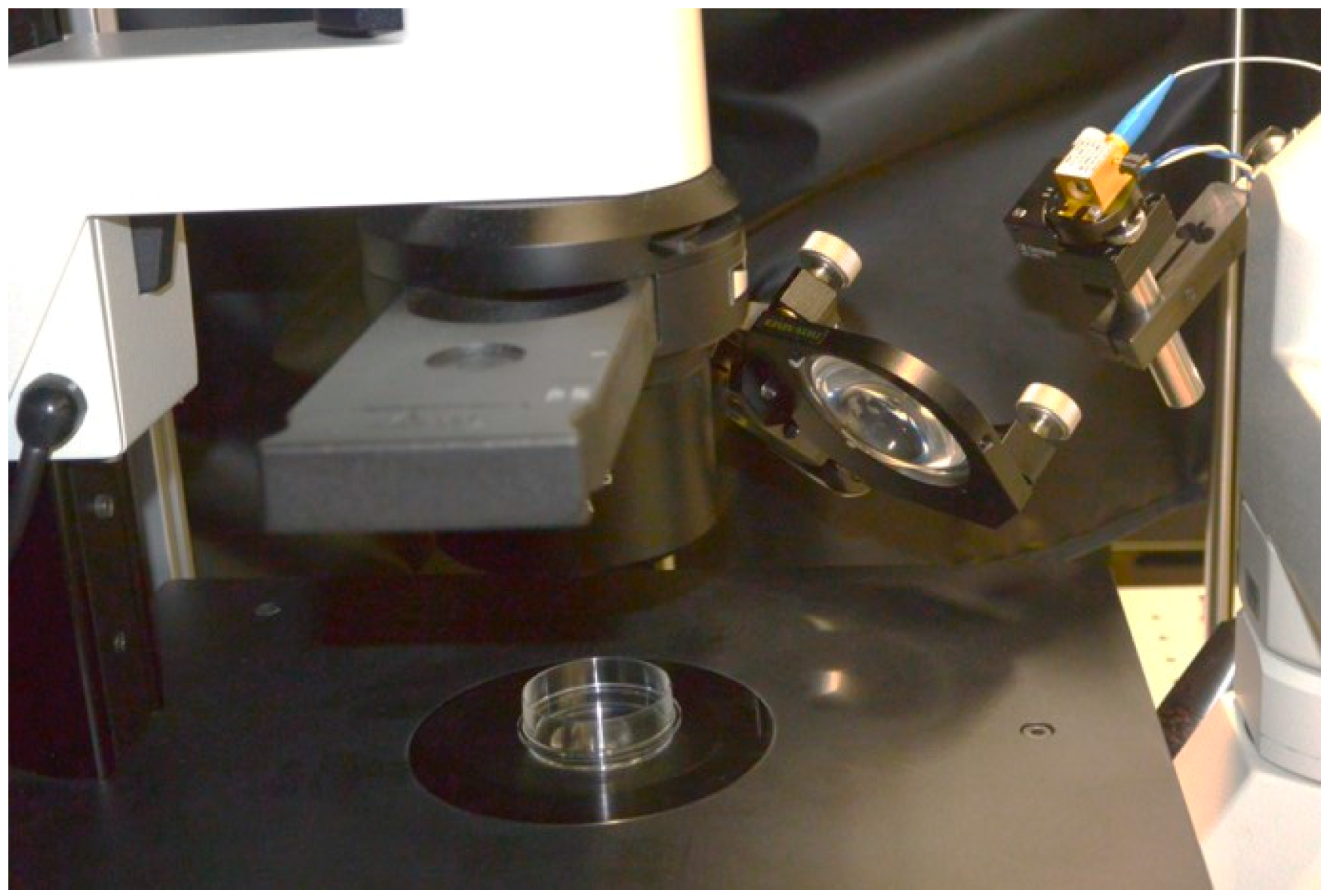
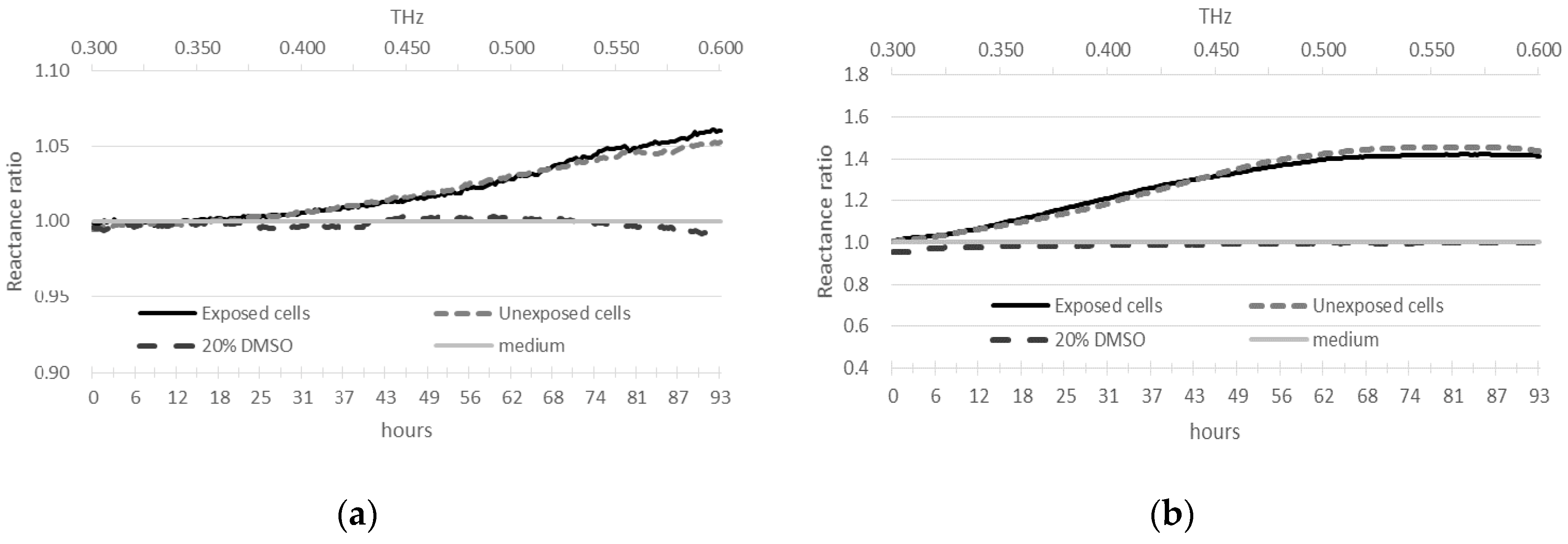
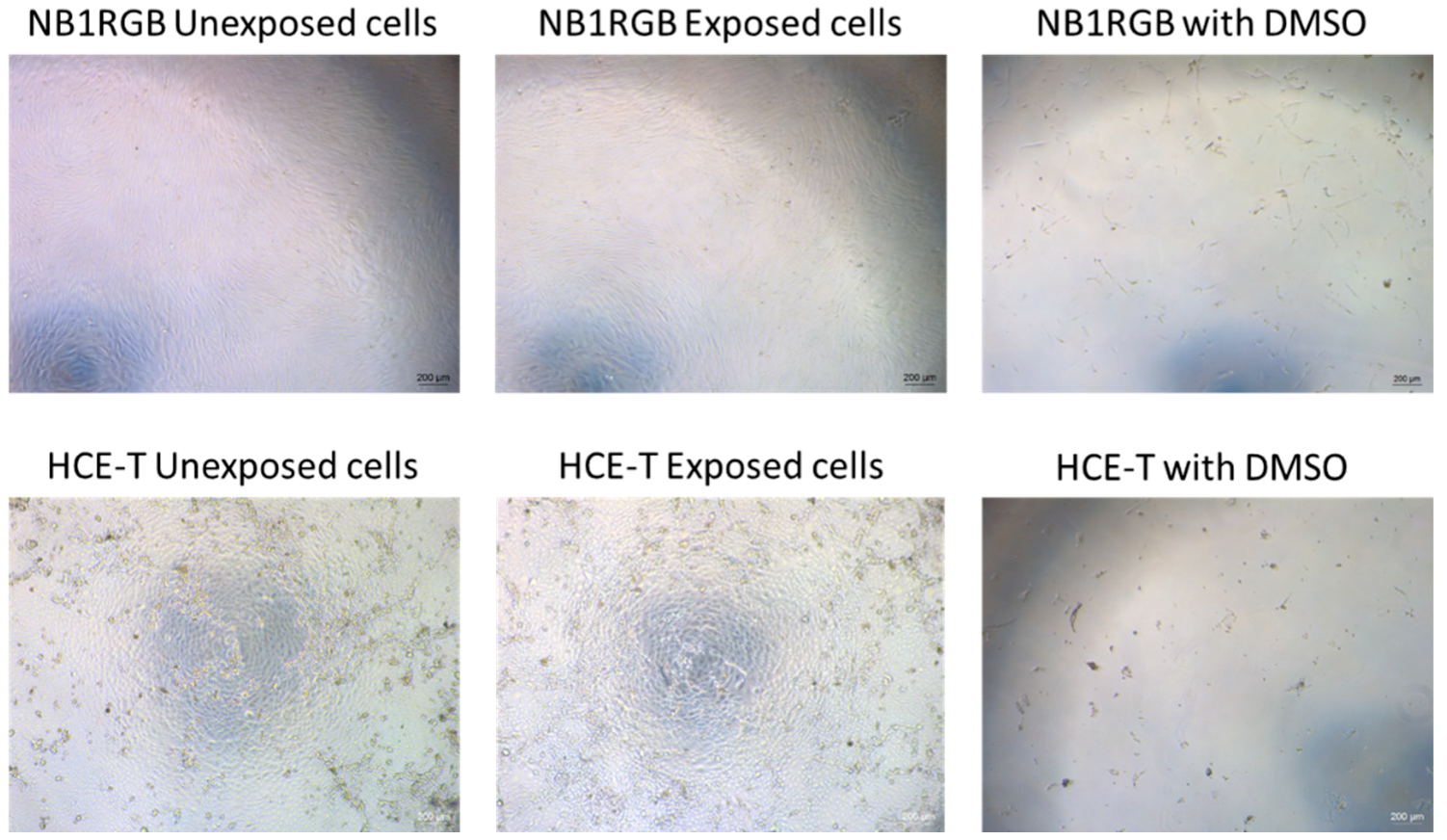

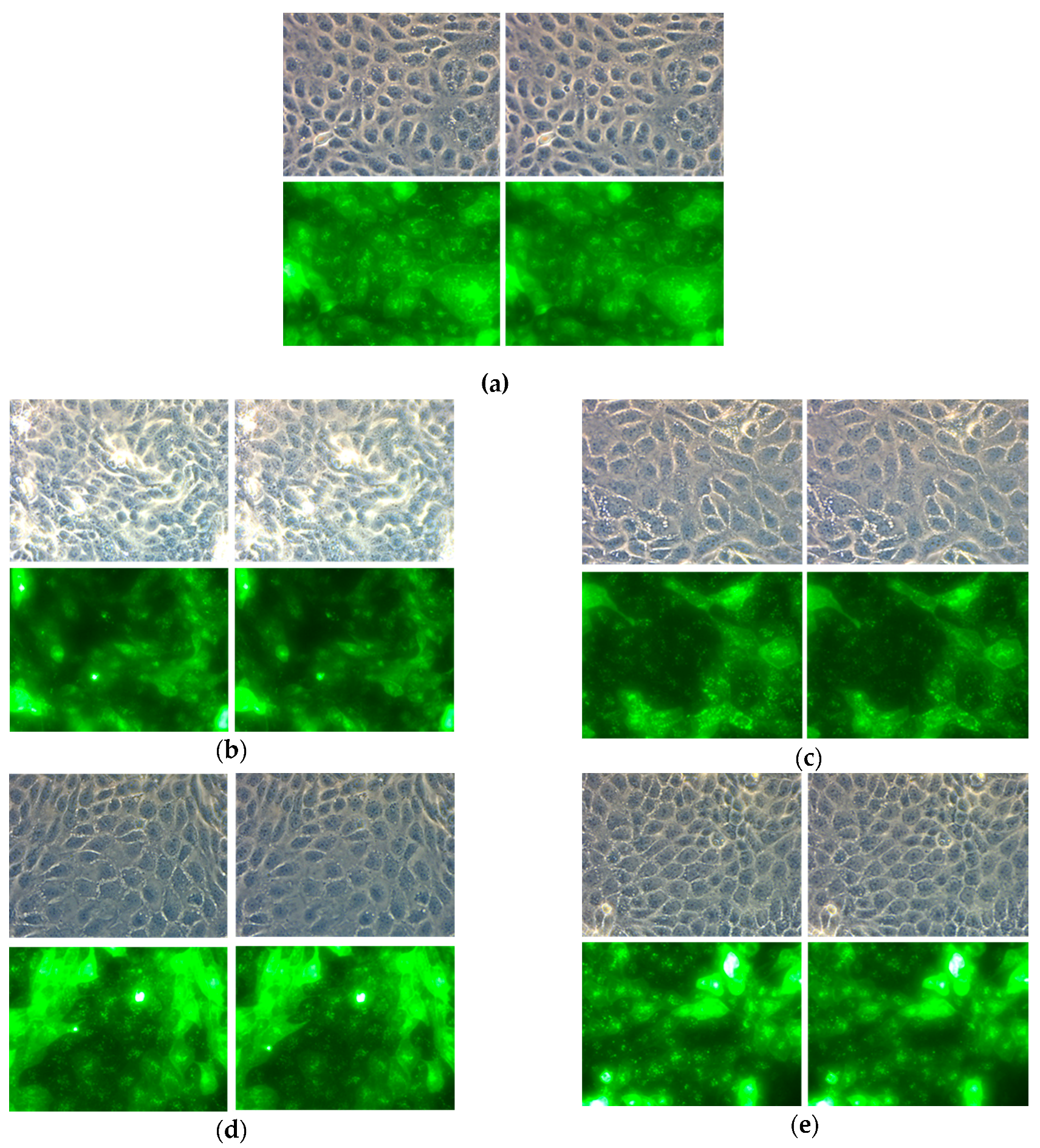
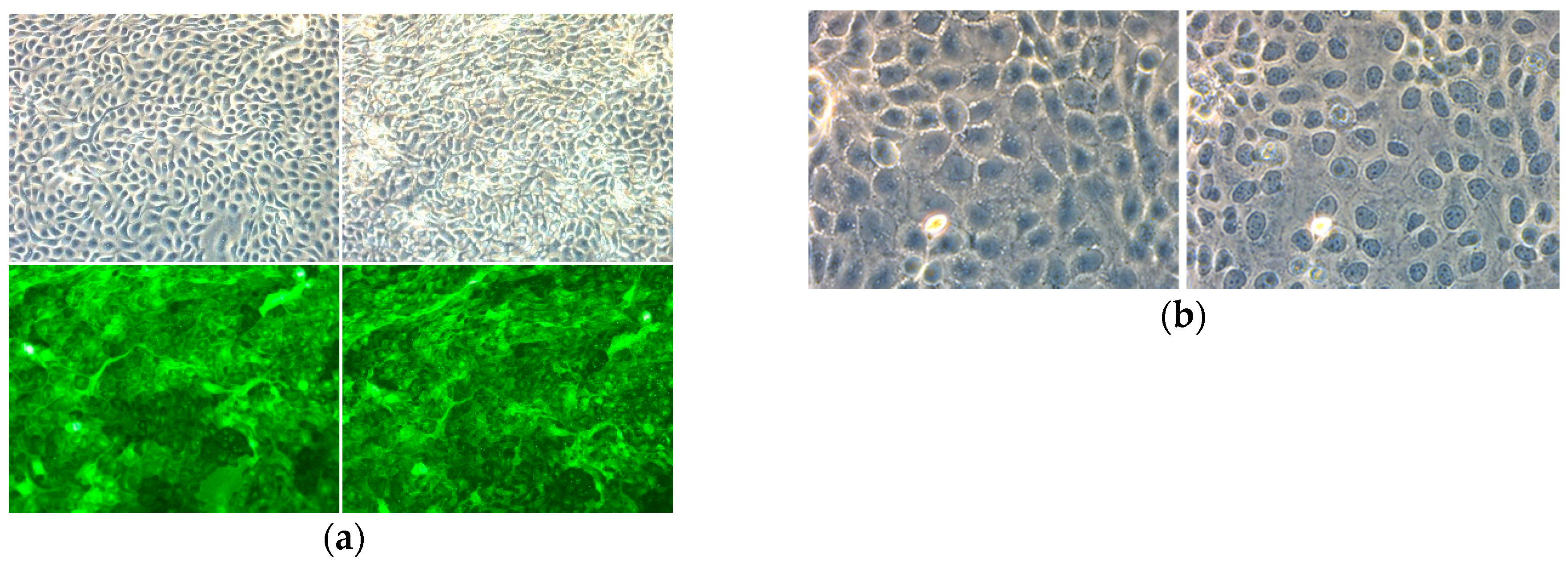
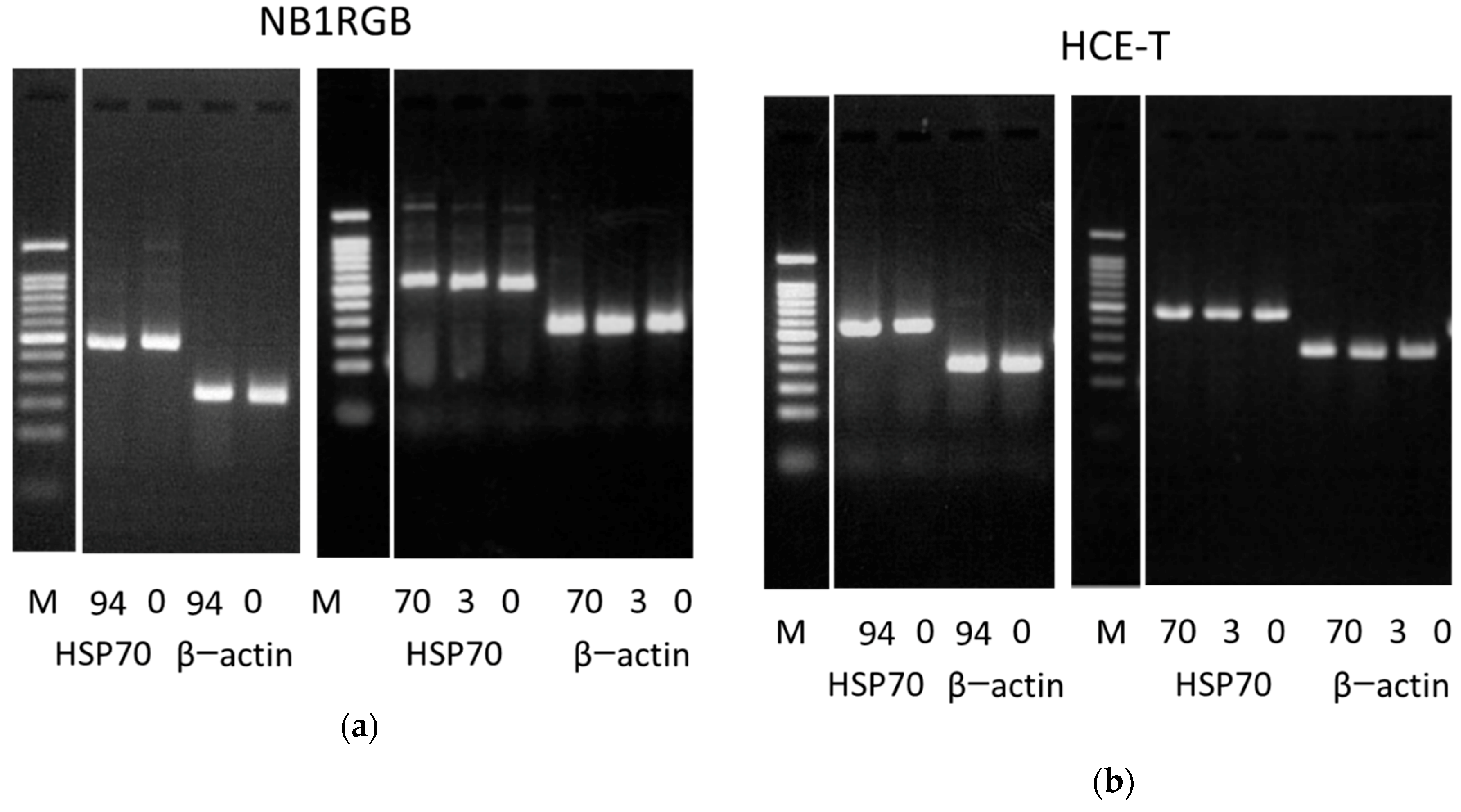
| Gene | Sequence | Amplified Length (bps) | Sequence Reference | |
|---|---|---|---|---|
| HSP70 | sense: antisense: | 5′- TTCCGTTTCCAGCCCCCAATC -3′ 5′- CGTTGAGCCCCGCGATGACA -3′ | 558 | Wang. 1999 |
| β-actin | sense: antisense: | 5′- CCGCGAGAAGATGACCCAGAT -3′ 5′- TTCTCCTTAATGTCACGCACGAT -3′ | 299 | Lixia. 2006 |
© 2019 by the authors. Licensee MDPI, Basel, Switzerland. This article is an open access article distributed under the terms and conditions of the Creative Commons Attribution (CC BY) license (http://creativecommons.org/licenses/by/4.0/).
Share and Cite
Yaekashiwa, N.; Yoshida, H.; Otsuki, S.; Hayashi, S.; Kawase, K. Verification of Non-thermal Effects of 0.3–0.6 THz-Waves on Human Cultured Cells. Photonics 2019, 6, 33. https://doi.org/10.3390/photonics6010033
Yaekashiwa N, Yoshida H, Otsuki S, Hayashi S, Kawase K. Verification of Non-thermal Effects of 0.3–0.6 THz-Waves on Human Cultured Cells. Photonics. 2019; 6(1):33. https://doi.org/10.3390/photonics6010033
Chicago/Turabian StyleYaekashiwa, Noriko, Hisa Yoshida, Sato Otsuki, Shin’ichiro Hayashi, and Kodo Kawase. 2019. "Verification of Non-thermal Effects of 0.3–0.6 THz-Waves on Human Cultured Cells" Photonics 6, no. 1: 33. https://doi.org/10.3390/photonics6010033
APA StyleYaekashiwa, N., Yoshida, H., Otsuki, S., Hayashi, S., & Kawase, K. (2019). Verification of Non-thermal Effects of 0.3–0.6 THz-Waves on Human Cultured Cells. Photonics, 6(1), 33. https://doi.org/10.3390/photonics6010033





